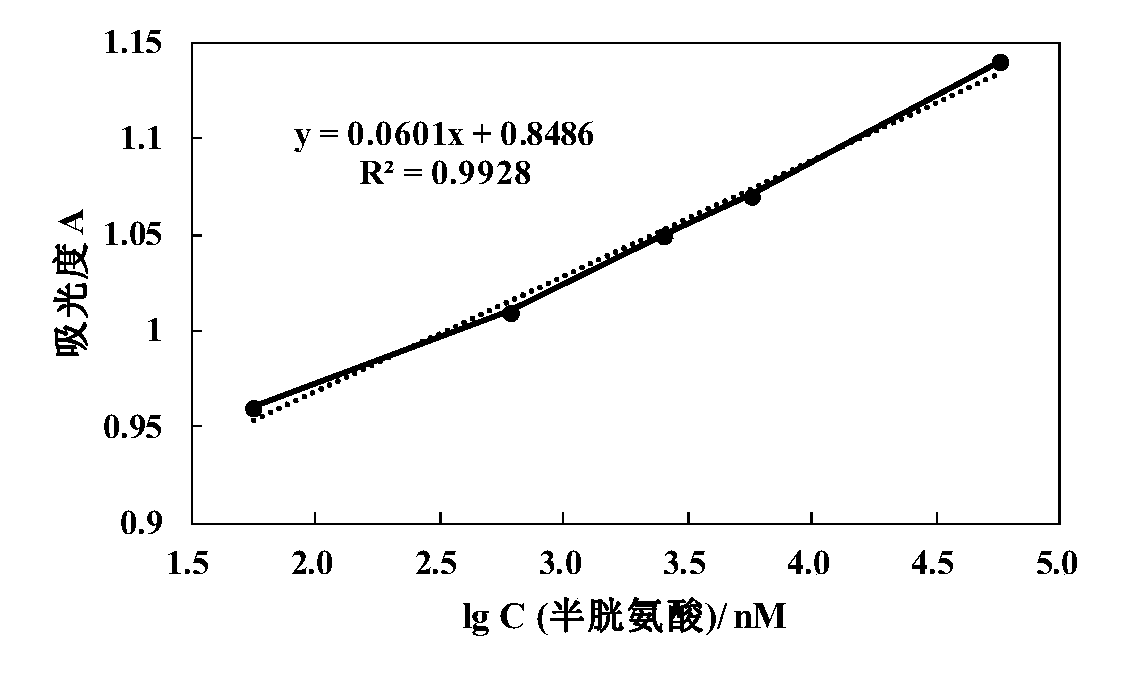Sensor for L-cysteine detection and detection method
A cysteine and sensor technology, applied in the field of chemical sensors, can solve the problems of reducing the concentration of hydroxyl radicals in active species, weakening the activity of catalytic hydrogen peroxide decomposition, and the inability to decolorize and decolorize dyes, and achieve a wide detection range. The effect of low cost and convenient preparation
- Summary
- Abstract
- Description
- Claims
- Application Information
AI Technical Summary
Problems solved by technology
Method used
Image
Examples
Embodiment 1
[0040] 0.5g Ba with an average particle size of 200nm calcined at 900℃ 0.5 Sr 0.5 co 0.75 Fe 0.2 Ag 0.05 o 3 (Ag-BSCF) ceramic powder was dispersed in deionized water, and then transferred to a 1L volumetric flask to obtain a suspension with a concentration of 0.5g / L for determining the L-cysteine content.
[0041] Preparation of L-cysteine stock solution: Dissolve 0.485 g of L-cysteine in deionized water, and then use a 1 L volumetric flask to obtain a 4 mM L-cysteine stock solution.
[0042] Preparation of L-cysteine standard solution: Take 25mL and 2.5mL of 4mM L-cysteine stock solution respectively and put them into a 100mL volumetric flask to obtain 1mM and 0.1mM L-cysteine standard solution. Then use the same method to prepare the two standard solutions into L-cysteine standard solutions with various concentrations ranging from 0.01 to 400 μM.
[0043] Preparation of other solutions: Dissolve 20mg of methylene blue and 30.738g of PMS in deionized wa...
Embodiment 2
[0049] Prepare the Ag-BSCF suspension of 0.5g / L by the method of embodiment 1.
[0050] The preparation methods of L-cysteine stock solution and standard solution and other solutions are the same as in Example 1. Dissolve 20mg of rhodamine 6G in deionized water, and then use a 1L volumetric flask to obtain a 20ppm rhodamine 6G solution for later use.
[0051] Preparation of detection solution: 50 μL of Ag-BSCF suspension with a concentration of 0.5 g / L, 50 μL of L-cysteine solution at various concentrations (0.01 μM-400 μM), 600 μL of 20 ppm rhodamine 6G solution and 10 μL (50 mM ) PMS solution was shaken and mixed at room temperature and aged for 3 minutes, and then centrifuged at 8000 rpm for 1 minute to obtain a mixed solution for detection.
[0052] Draw a working curve and determine the content of L-cysteine: transfer 200 μL of the above detection solution to a 96-well plate, and measure the absorbance at a wavelength of 529 nm with the solution without L-cysteine ...
Embodiment 3
[0056] 0.5g of La with an average particle size of 150nm calcined at 850°C 0.6 Sr 0.4 co 0.2 Fe 0.75 Ag 0.05 o 3 (Ag-LSCF) ceramic powder was dispersed in deionized water, and then transferred to a 1L volumetric flask to obtain a suspension with a concentration of 0.5g / L for determining the L-cysteine content.
[0057] Preparation of L-cysteine stock solution: Dissolve 0.485 g of L-cysteine in deionized water, and then use a 1 L volumetric flask to obtain a 4 mM L-cysteine stock solution.
[0058] Preparation of L-cysteine standard solution: Take 25mL and 2.5mL of 4mM L-cysteine stock solution respectively and put them into a 100mL volumetric flask to obtain 1mM and 0.1mM L-cysteine standard solution. Then use the same method to prepare the two standard solutions into L-cysteine standard solutions with various concentrations ranging from 0.01 to 400 μM.
[0059] Preparation of other solutions: Dissolve 20mg of methylene blue and 24.60g of PMS in deionized...
PUM
| Property | Measurement | Unit |
|---|---|---|
| diameter | aaaaa | aaaaa |
| particle size | aaaaa | aaaaa |
| particle size | aaaaa | aaaaa |
Abstract
Description
Claims
Application Information
 Login to View More
Login to View More - R&D Engineer
- R&D Manager
- IP Professional
- Industry Leading Data Capabilities
- Powerful AI technology
- Patent DNA Extraction
Browse by: Latest US Patents, China's latest patents, Technical Efficacy Thesaurus, Application Domain, Technology Topic, Popular Technical Reports.
© 2024 PatSnap. All rights reserved.Legal|Privacy policy|Modern Slavery Act Transparency Statement|Sitemap|About US| Contact US: help@patsnap.com










